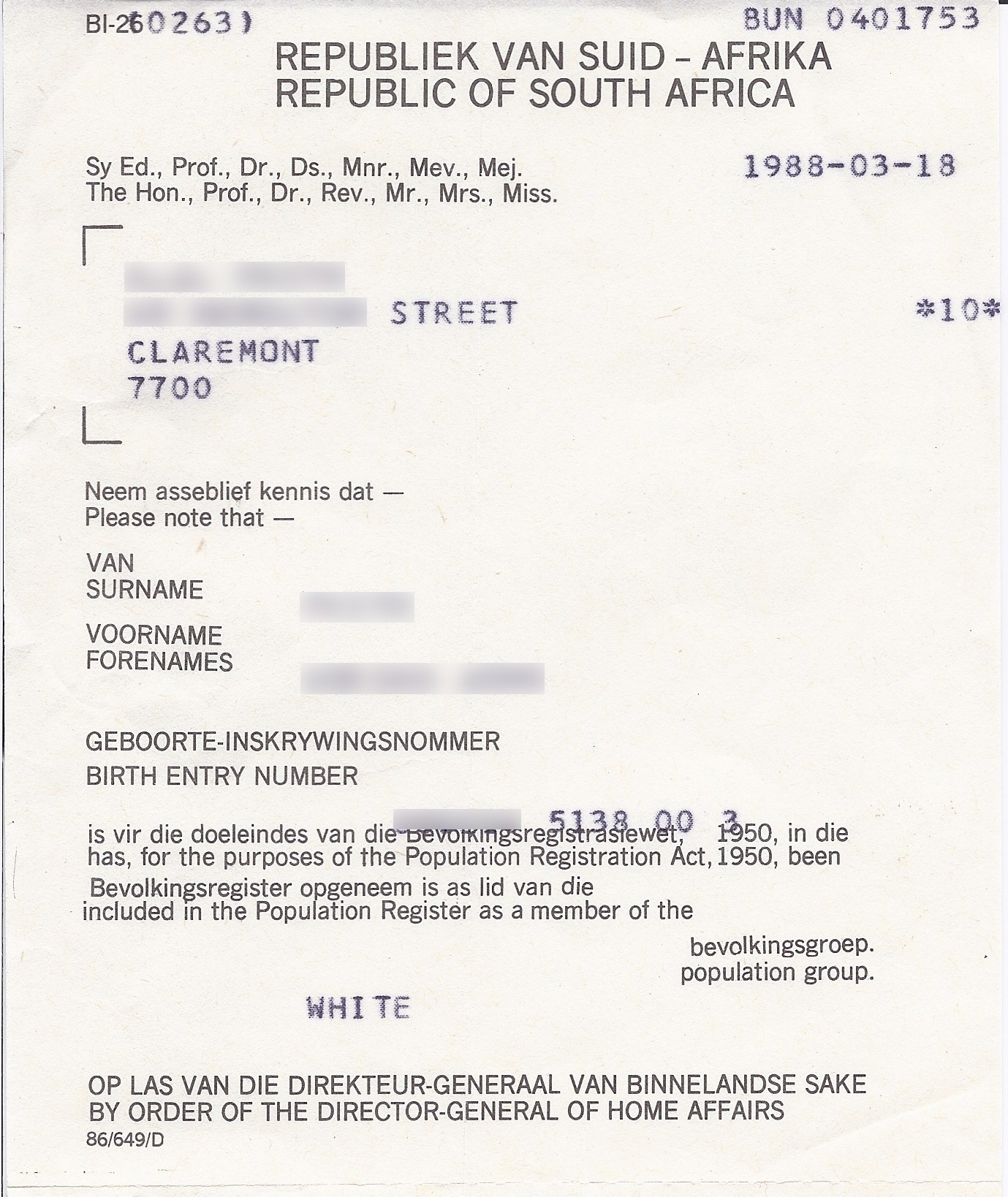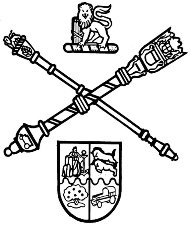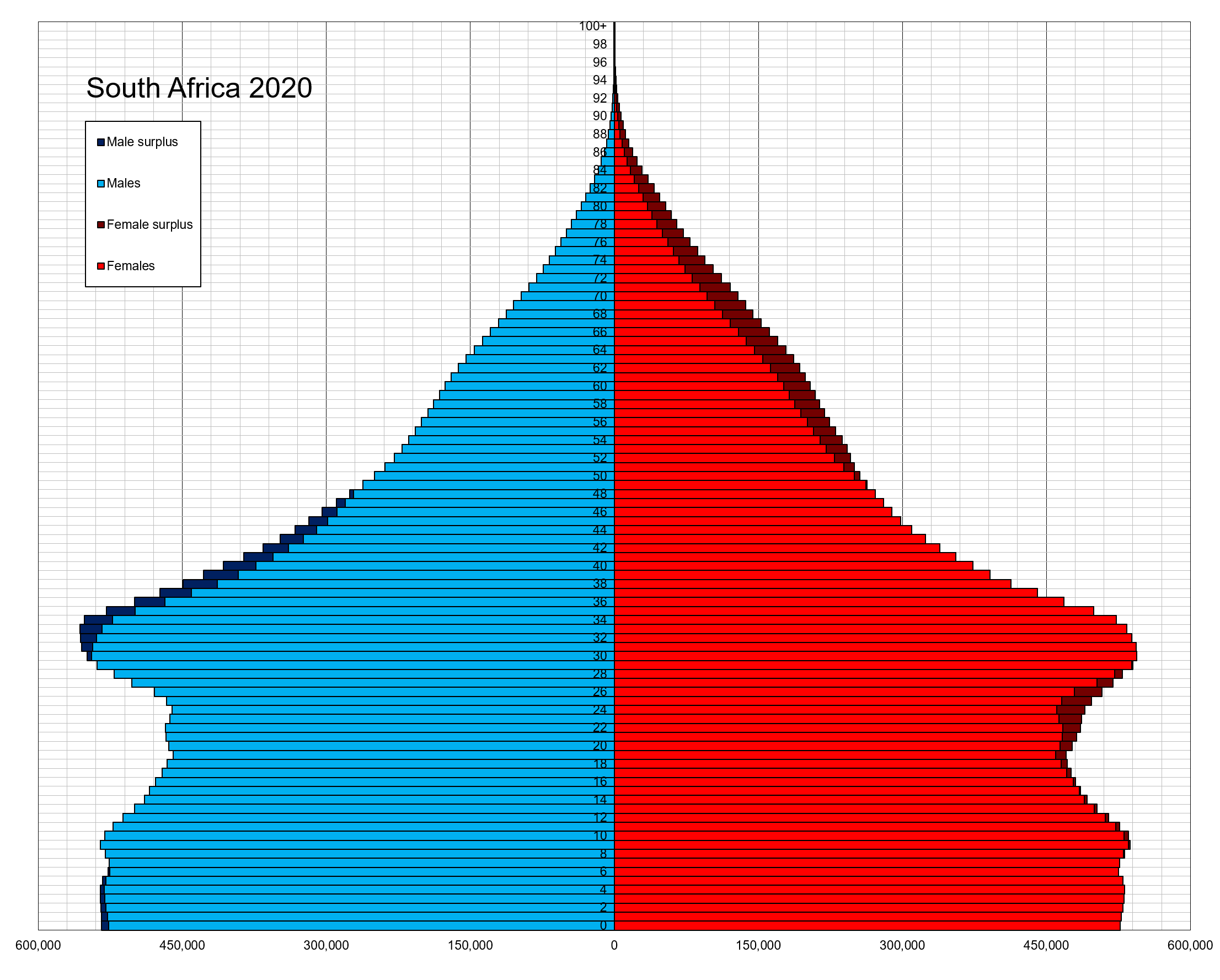|
Population Registration Act
The Population Registration Act of 1950 required that each inhabitant of South Africa be classified and registered in accordance with their racial characteristics as part of the system of apartheid. Social rights, political rights, educational opportunities, and economic status were largely determined by the group to which an individual belonged. There were three basic racial classifications under the law: Black, White and Coloured (mixed). Indians (that is, South Asians from the former British India, and their descendants) were later added as a separate classification as they were seen as having "no historical right to the country". An ''Office for Race Classification'' was set up to overview the classification process. Classification into groups was carried out using criteria such as outer appearance, general acceptance and social standing. For example, it defined a "white person" as one who "in appearance is obviously a white person who is generally not accepted as a colo ... [...More Info...] [...Related Items...] OR: [Wikipedia] [Google] [Baidu] |
Parliament Of South Africa
The Parliament of the Republic of South Africa is South Africa's legislature; under the present Constitution of South Africa, the bicameral Parliament comprises a National Assembly and a National Council of Provinces. The current twenty-seventh Parliament was first convened on 22 May 2019. From 1910 to 1994, members of Parliament were elected chiefly by the South African white minority. The first elections with universal suffrage were held in 1994. Both chambers held their meetings in the Houses of Parliament, Cape Town that were built 1875–1884. A fire broke out within the buildings in early January 2022, destroying the session room of the National Assembly. The National Assembly will temporarily meet at the Good Hope Chamber. History Before 1910 The predecessor of the Parliament of South Africa, before the 1910 Union of South Africa, was the bicameral Parliament of the Cape of Good Hope. This was composed of the House of Assembly (the lower house) and the Legislati ... [...More Info...] [...Related Items...] OR: [Wikipedia] [Google] [Baidu] |
Cape Coloureds
Cape Coloureds () are a South African ethnic group consisted primarily of persons of mixed race and Khoisan descent. Although Coloureds form a minority group within South Africa, they are the predominant population group in the Western Cape. They are generally bilingual, speaking Afrikaans and English, though some speak only one of these. Some Cape Coloureds may code switch, speaking a patois of Afrikaans and English called also known as Cape Slang (Capy) or , meaning Kitchen Afrikaans. Cape Coloureds were classified under apartheid as a subset of the larger Coloured race group. At least one genetic study indicates that Cape Coloureds have an ancestry consisting of the following ethnic groups: * Khoisan: (32–43%) * Bantu-speaking Africans: (20–36%) * Ethnic groups in Europe: (21–28%) * Asian peoples: (9–11%) Origin and history The Cape Coloureds are a heterogeneous South African ethnic group, with diverse ancestral links. Ancestry may include European settlers, i ... [...More Info...] [...Related Items...] OR: [Wikipedia] [Google] [Baidu] |
Urban Apartheid
Social apartheid is de facto segregation on the basis of class or economic status, in which an underclass is forced to exist separated from the rest of the population. The word "apartheid", originally an Afrikaans word meaning "separation", gained its current meaning during the South African apartheid that took place between 1948 and early 1994, in which the government declared certain regions as being "for whites only", with the black population forcibly relocated to remote designated areas. Urban apartheid Typically a component in social apartheid, urban apartheid refers to the spatial segregation of minorities to remote areas. In the context of the South African apartheid, this is defined by the reassignation of the four racial groups defined by the Population Registration Act of 1950, into group areas as outlined by the Group Areas Act of 1950. Outside of the South African context, the term has also come to be used to refer to ghettoization of minority populations in cities wit ... [...More Info...] [...Related Items...] OR: [Wikipedia] [Google] [Baidu] |
Pencil Test (South Africa)
The pencil test is a method of assessing whether a person has Afro-textured hair. In the pencil test, a pencil is pushed through the person's hair. How easily it comes out determines whether the person has "passed" or "failed" the test. This test was used to determine racial identity in South Africa during the apartheid era, distinguishing whites from coloureds and blacks. The test was partially responsible for splitting existing communities and families along perceived racial lines. Its formal authority ended with the end of apartheid in 1994. It remains an important part of South African cultural heritage and a symbol of racism. Background The Population Registration Act required the classification of South Africans into racial groups based on physical and socio-economic characteristics. Since a person's racial heritage was not always clear, a variety of tests were devised to help authorities classify people. One such test was the pencil test. The pencil test involved s ... [...More Info...] [...Related Items...] OR: [Wikipedia] [Google] [Baidu] |
Demographics Of South Africa
The population of South Africa is about 58.8 million people of diverse origins, cultures, languages, and religions. The South African National Census of 2022 was the most recent census held; the next will be in 2032. In 2011, Statistics South Africa counted 2.1 million foreigners in total. Reports suggest that is an underestimation. The real figure may be as high as five million, including some three million Zimbabweans. History Population Earlier Censuses, 1904 to 2011 1904 Census South African population figures for the 1904 Census.Smuts I: The Sanguine Years 1870–1919, W.K. Hancock, Cambridge University Press, 1962, pg 219 1960 Census Sources: '' Statesman's Year-Book'' 1967–1968; '' Europa Year Book'' 1969 1904-85 national census numbers Bantustan demographics were removed from South African census data during Apartheid and for this reason official figures on the national population of the country during that period will be inaccurate. 1996 Census Source: ... [...More Info...] [...Related Items...] OR: [Wikipedia] [Google] [Baidu] |
Black Economic Empowerment
Black Economic Empowerment (BEE) is a policy of the South African government which aims to facilitate broader participation in the economy by black people. A form of affirmative action, it is intended especially to redress the inequalities created by apartheid. The policy provides incentives – especially preferential treatment in government procurement processes – to businesses which contribute to black economic empowerment according to several measurable criteria, including through partial or majority black ownership, hiring black employees, and contracting with black-owned suppliers. The preferential procurement aspect of BEE has been viewed as paradigmatic of a sustainable procurement approach, whereby government procurement is used to advance social policy objectives. So-called "BEE deals" – transactions aiming to increase black ownership of large businesses – have been conducted on a large scale, with BEE transactions concluded between 1994 and 2005 valued at between ... [...More Info...] [...Related Items...] OR: [Wikipedia] [Google] [Baidu] |
Culture Of South Africa
South Africa is known for its ethnic and cultural diversity. Amongst black South Africans, a substantial number of rural inhabitants lead largely impoverished lives. Almost all South Africans speak English to some degree of proficiency, in addition to their native language, with English acting as a lingua franca in commerce, education, and government. South Africa has eleven official languages, but other indigenous languages are also spoken by smaller groups, chiefly Khoisan languages. Members of the middle class, who are predominantly white and Indian but whose ranks include growing numbers of other groups, have lifestyles similar in many respects to that of people found in Western Europe, North America, Australia and New Zealand. The Apartheid state legally classified South Africans into one of four race groups, and determined where they could live, and enforced segregation in education, work opportunities, public amenities and social relations. Although these laws were ab ... [...More Info...] [...Related Items...] OR: [Wikipedia] [Google] [Baidu] |
South African Parliament
The Parliament of the Republic of South Africa is South Africa's legislature; under the present Constitution of South Africa, the bicameral Parliament comprises a National Assembly and a National Council of Provinces. The current twenty-seventh Parliament was first convened on 22 May 2019. From 1910 to 1994, members of Parliament were elected chiefly by the South African white minority. The first elections with universal suffrage were held in 1994. Both chambers held their meetings in the Houses of Parliament, Cape Town that were built 1875–1884. A fire broke out within the buildings in early January 2022, destroying the session room of the National Assembly. The National Assembly will temporarily meet at the Good Hope Chamber. History Before 1910 The predecessor of the Parliament of South Africa, before the 1910 Union of South Africa, was the bicameral Parliament of the Cape of Good Hope. This was composed of the House of Assembly (the lower house) and the Legislativ ... [...More Info...] [...Related Items...] OR: [Wikipedia] [Google] [Baidu] |
Indian South Africans
Indian South Africans are South Africans who descend from indentured labourers and free migrants who arrived from British India during the late 1800s and early 1900s. The majority live in and around the city of Durban, making it one of the largest "Indian" populated cities outside of India. As a consequence of the policies of apartheid, ''Indian'' (synonymous with ''Asian)'' is regarded as a race group in South Africa. Racial identity During the colonial era, Indians were accorded the same subordinate status in South African society as Blacks were by the white minority, which held the vast majority of political power. During the period of apartheid from 1948 to 1994, Indian South Africans were called and often voluntarily accepted, terms which ranged from "Asians" to "Indians", and were legally classified as being members of a single racial group. Some Indian South Africans believed that these terms were improvements on the negatively defined identity of "Non-White", which ... [...More Info...] [...Related Items...] OR: [Wikipedia] [Google] [Baidu] |
Chinese South African
Chinese South Africans () are Overseas Chinese who reside in South Africa, including those whose ancestors came to South Africa in the early 20th century until Chinese immigration was banned under the Chinese Exclusion Act of 1904. Chinese industrialists from the Republic of China (Taiwan) who arrived in the 1970s, 1980s and early 1990s, and post-apartheid immigrants to South Africa (predominantly from mainland China) now outnumber locally-born Chinese South Africans. South Africa has the largest population of Chinese in Africa, and most of them live in Johannesburg, an economic hub in southern Africa. History First settlers The first Chinese to settle in South Africa were prisoners, usually debtors, exiled from Batavia by the Dutch to their then newly founded colony at Cape Town in 1660. Originally the Dutch wanted to recruit Chinese settlers to settle in the colony as farmers, thereby helping establish the colony and create a tax base so the colony would be less of a d ... [...More Info...] [...Related Items...] OR: [Wikipedia] [Google] [Baidu] |
Griqua People
The Griquas (; af, Griekwa, often confused with ''!Orana'', which is written as ''Korana'' or ''Koranna'') are a subgroup of heterogeneous former Khoe-speaking nations in Southern Africa with a unique origin in the early history of the Cape Colony. Text was copied from this source, which is available under a Creative Commons license. Under apartheid, they were given a special racial classification under the broader category of "Coloured". Similar to the Trekboers (another Afrikaans-speaking group of the time), they originally populated the frontiers of the nascent Cape Colony (founded in 1652). The men of their semi-nomadic society formed commando units of mounted gunmen. Like the Boers, they migrated inland from the Cape, in the 19th century establishing several states in what are now South Africa and Namibia. Griqua was the name given to a mixed-race culture in the Cape Colony of South Africa, around the 17th and 18th Century (Taylor, 2020). They were also known as Hotten ... [...More Info...] [...Related Items...] OR: [Wikipedia] [Google] [Baidu] |




.jpg)


